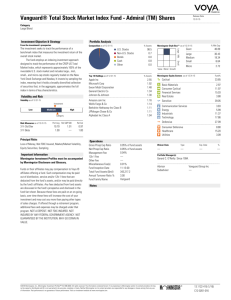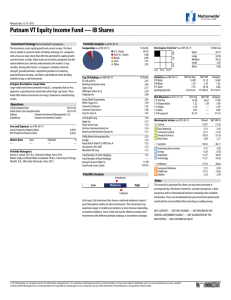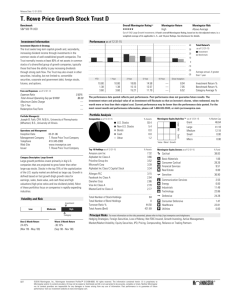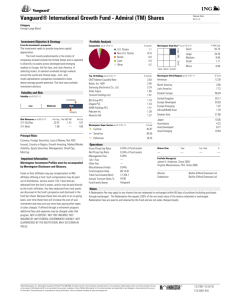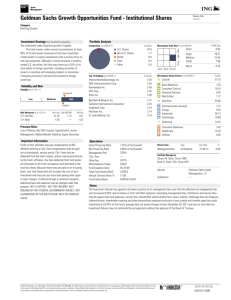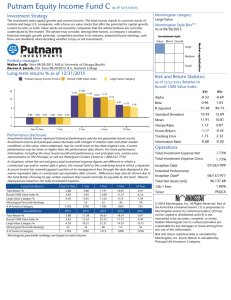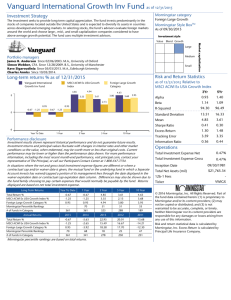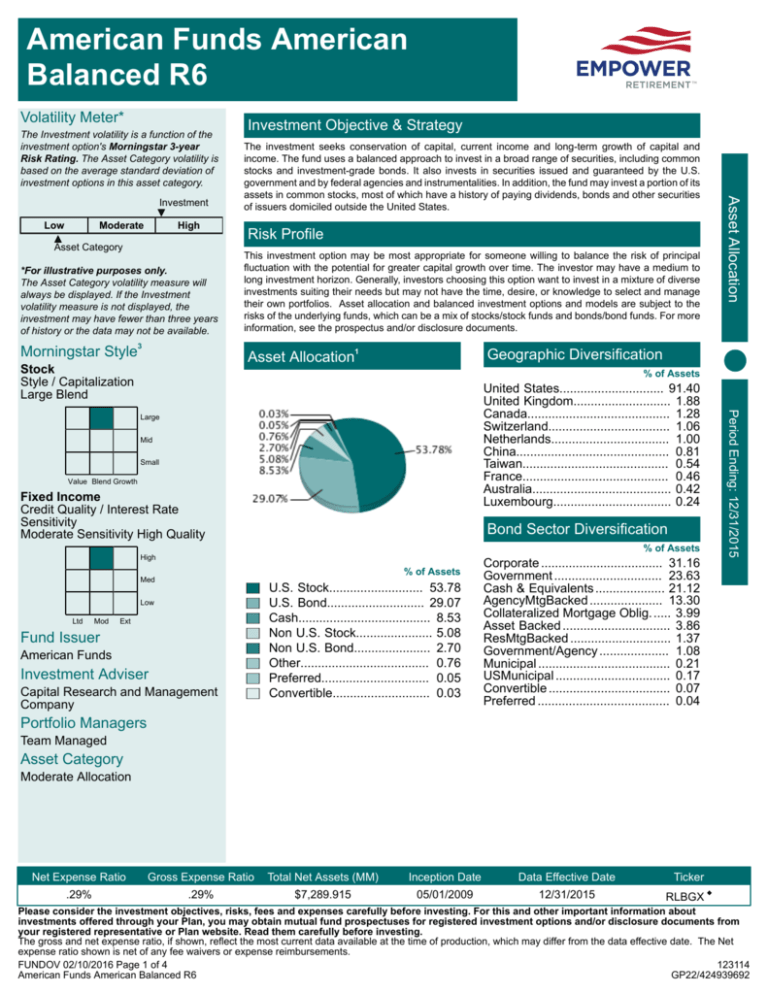
American Funds American
Balanced R6
Volatility Meter*
The Investment volatility is a function of the
investment option's Morningstar 3-year
Risk Rating. The Asset Category volatility is
based on the average standard deviation of
investment options in this asset category.
Low
Moderate
▲
Asset Category
*For illustrative purposes only.
The Asset Category volatility measure will
always be displayed. If the Investment
volatility measure is not displayed, the
investment may have fewer than three years
of history or the data may not be available.
Risk Profile
This investment option may be most appropriate for someone willing to balance the risk of principal
fluctuation with the potential for greater capital growth over time. The investor may have a medium to
long investment horizon. Generally, investors choosing this option want to invest in a mixture of diverse
investments suiting their needs but may not have the time, desire, or knowledge to select and manage
their own portfolios. Asset allocation and balanced investment options and models are subject to the
risks of the underlying funds, which can be a mix of stocks/stock funds and bonds/bond funds. For more
information, see the prospectus and/or disclosure documents.
3
Morningstar Style
1
Geographic Diversification
Asset Allocation
Stock
Style / Capitalization
Large Blend
% of Assets
Mid
Small
Value Blend Growth
Fixed Income
Credit Quality / Interest Rate
Sensitivity
Moderate Sensitivity High Quality
Bond Sector Diversification
% of Assets
High
% of Assets
Med
Low
Mod
Ext
Fund Issuer
American Funds
Investment Adviser
Capital Research and Management
Company
U.S. Stock........................... 53.78
U.S. Bond............................ 29.07
Cash...................................... 8.53
Non U.S. Stock...................... 5.08
Non U.S. Bond...................... 2.70
Other..................................... 0.76
Preferred............................... 0.05
Convertible............................ 0.03
Period Ending: 12/31/2015
United States.............................. 91.40
United Kingdom............................ 1.88
Canada......................................... 1.28
Switzerland................................... 1.06
Netherlands.................................. 1.00
China............................................ 0.81
Taiwan.......................................... 0.54
France.......................................... 0.46
Australia........................................ 0.42
Luxembourg.................................. 0.24
Large
Ltd
Asset Allocation
Investment
▼
High
Investment Objective & Strategy
The investment seeks conservation of capital, current income and long-term growth of capital and
income. The fund uses a balanced approach to invest in a broad range of securities, including common
stocks and investment-grade bonds. It also invests in securities issued and guaranteed by the U.S.
government and by federal agencies and instrumentalities. In addition, the fund may invest a portion of its
assets in common stocks, most of which have a history of paying dividends, bonds and other securities
of issuers domiciled outside the United States.
Corporate ................................... 31.16
Government ............................... 23.63
Cash & Equivalents .................... 21.12
AgencyMtgBacked ..................... 13.30
Collateralized Mortgage Oblig. ..... 3.99
Asset Backed ............................... 3.86
ResMtgBacked ............................. 1.37
Government/Agency .................... 1.08
Municipal ...................................... 0.21
USMunicipal ................................. 0.17
Convertible ................................... 0.07
Preferred ...................................... 0.04
Portfolio Managers
Team Managed
Asset Category
Moderate Allocation
Net Expense Ratio
Gross Expense Ratio
Total Net Assets (MM)
Inception Date
Data Effective Date
.29%
.29%
$7,289.915
05/01/2009
12/31/2015
Ticker
RLBGX
Please consider the investment objectives, risks, fees and expenses carefully before investing. For this and other important information about
investments offered through your Plan, you may obtain mutual fund prospectuses for registered investment options and/or disclosure documents from
your registered representative or Plan website. Read them carefully before investing.
The gross and net expense ratio, if shown, reflect the most current data available at the time of production, which may differ from the data effective date. The Net
expense ratio shown is net of any fee waivers or expense reimbursements.
FUNDOV 02/10/2016 Page 1 of 4
123114
American Funds American Balanced R6
GP22/424939692
American Funds American
Balanced R6
Volatility Meter*
The Investment volatility is a function of the
investment option's Morningstar 3-year
Risk Rating. The Asset Category volatility is
based on the average standard deviation of
investment options in this asset category.
Low
Moderate
▲
Asset Category
*For illustrative purposes only.
The Asset Category volatility measure will
always be displayed. If the Investment
volatility measure is not displayed, the
investment may have fewer than three years
of history or the data may not be available.
3
Morningstar Style
Stock
Style / Capitalization
Large Blend
Mid
Small
Value Blend Growth
Fixed Income
Credit Quality / Interest Rate
Sensitivity
Moderate Sensitivity High Quality
Med
Low
Mod
1 - 3 Years.................................. 10.86
3 - 5 Years.................................. 23.88
5 - 7 Years................................... 9.43
7 - 10 Years................................ 21.07
10 - 15 Years................................ 2.37
15 - 20 Years................................ 4.45
20 - 30 Years.............................. 23.13
Over 30 Years.............................. 4.81
Largest Holdings
For more information about this
investment option please go to
www.americanfunds.com.
% of Assets
Microsoft Corp.............................. 4.12
Philip Morris International Inc....... 2.63
Amazon.com Inc........................... 2.42
Comcast Corp Class A................. 2.35
Wells Fargo & Co......................... 2.14
Home Depot Inc........................... 2.13
Berkshire Hathaway Inc Class A.. 1.96
Coca-Cola Co............................... 1.95
JPMorgan Chase & Co................. 1.73
Lockheed Martin Corp.................. 1.63
Percent of Total Net Assets 23.06%
Number of Holdings
1,506
Portfolio Turnover (%)
68.00%
Risk Statistics (3 Year)^
Alpha............................................ 4.29
Beta.............................................. 1.11
R-Squared.................................. 90.25
Sharpe Ratio................................ 1.39
Standard Deviation....................... 7.61
High
Ltd
% of Assets
Financial Svc.............................. 18.35
Technology................................. 16.51
Consumer Defensive.................. 14.28
Consumer Cyclical..................... 12.53
Healthcare.................................. 11.45
Industrials................................... 10.56
Energy.......................................... 6.73
Communication Svc..................... 5.01
Basic Materials............................. 4.32
Utilities.......................................... 0.25
Period Ending: 12/31/2015
Large
Maturity Allocation
% of Assets
Asset Allocation
Investment
▼
High
Equity Sector Diversification
^Risk Statistics are measured using the S&P
500 TR USD benchmark, where applicable.
The rating, risk, and return values are relative to
each fund's asset category.
Ext
Fund Issuer
American Funds
Investment Adviser
Capital Research and Management
Company
Credit Quality - Bond
2
% of Assets
AAA............................................ 69.05
AA................................................. 4.76
A................................................. 14.29
BBB............................................. 11.64
Not Rated..................................... 0.26
Portfolio Managers
Team Managed
Asset Category
Moderate Allocation
Net Expense Ratio
Gross Expense Ratio
Total Net Assets (MM)
Inception Date
Data Effective Date
.29%
.29%
$7,289.915
05/01/2009
12/31/2015
Ticker
RLBGX
Please consider the investment objectives, risks, fees and expenses carefully before investing. For this and other important information about
investments offered through your Plan, you may obtain mutual fund prospectuses for registered investment options and/or disclosure documents from
your registered representative or Plan website. Read them carefully before investing.
The gross and net expense ratio, if shown, reflect the most current data available at the time of production, which may differ from the data effective date. The Net
expense ratio shown is net of any fee waivers or expense reimbursements.
FUNDOV 02/10/2016 Page 2 of 4
123114
American Funds American Balanced R6
GP22/424939692
Glossary & Investment Option Disclosures
An annualized measure of a fund's downside volatility over a three-year period. Morningstar Risk Rating is derived directly from Morningstar Risk,
3-Year
which is an assessment of the variations in a fund's monthly returns, with an emphasis on downside variations, in comparison to similar funds. In each
Risk Rating Morningstar Category, the top 10% of investments earn a High rating, the next 22.5% Above Average, the middle 35% Average, the next 22.5% Below
Average, and the bottom 10% Low. Investments with less than three years of performance history are not rated.
Alpha is a measure of the difference between a portfolio’s actual returns and its expected performance, given its level of risk as measured by beta. A
Alpha
positive Alpha figure indicates the portfolio has performed better than its beta would predict. In contrast, a negative Alpha indicates the portfolio has
underperformed, given the expectations established by beta.
Beta is a measure of a portfolio's sensitivity to market movements. The beta of the market is 1.00 by definition. Morningstar calculates beta by
comparing a portfolio's excess return over T-bills to the benchmark's excess return over T-bills, so a beta of 1.10 shows that the portfolio has
Beta
performed 10% better than its benchmark in up markets and 10% worse in down markets, assuming all other factors remain constant. Conversely, a
beta of 0.85 indicates that the portfolio's excess return is expected to perform 15% worse than the benchmark’s excess return during up markets and
15% better during down markets.
Effective duration for all long fixed income positions in a portfolio. Morningstar asks fund companies to calculate and send average effective duration
(also known as “option adjusted duration”) for each of their fixed income or allocation funds. We ask for effective duration because the measure gives
better estimation of how the price of bonds with embedded options, which are common in many mutual funds, will change as a result of changes in
Effective
interest rates. Effective duration takes into account expected mortgage prepayment or the likelihood that embedded options will be exercised if a
Duration
fund holds futures, other derivative securities, or other funds as assets, the aggregate effective duration should include the weighted impact of those
exposures. Standard practice for calculating this data point requires determination of a security’s option-adjusted spread, including the use of option
models or Monte Carlo simulation, as well as interest-rate scenario testing Morningstar requests that the fund only report data in this field that has
been specifically labeled effective or option-adjusted duration, or that fund is certain has been calculated in the fashion described.
Average effective maturity is a weighted average of all the maturities of the bonds in a portfolio, computed by weighting each bond's effective maturity
Effective
by the market value of the security. Average effective maturity takes into consideration all mortgage prepayments, puts, and adjustable coupons.
Maturity
Longer-maturity funds are generally considered more interest-rate sensitive than their shorter counterparts. We list Average Effective Maturity for
Taxable Fixed-Income and Hybrid funds and Average Nominal Maturity for Municipal Bond Funds.
The Morningstar U.S. Equity Style Box™ is a grid that provides a graphical representation of the investment style of stocks and portfolios. It classifies
securities according to market capitalization (the vertical axis) and 10 growth and value factors (the horizontal axis) and allows us to provide analysis
on a 3-by-3 Style Box - as well as providing the traditional style box assignment, which is the basis for the Morningstar Category. Two of the style
value and growth, are common to both stocks and portfolios. However, for stocks, the central column of the style box represents the core
Equity Style categories,
style (those stocks for which neither value nor growth characteristics dominate); for portfolios, it represents the blend style (a mixture of growth and
Box
value stocks or mostly core stocks). Furthermore, the core style for stocks is wider than the blend style for portfolios. In general, a growth-oriented
fund will hold the stocks of companies that the portfolio manager believes will increase earnings faster than the rest of the market. A value-oriented
fund contains mostly stocks the manager thinks are currently undervalued in price and will eventually see their worth recognized by the market. A
blend fund might be a mix of growth stocks and value stocks, or it may contain stocks that exhibit both characteristics.
The model for the fixed income style box is based on the two pillars of fixed-income performance: interest-rate sensitivity and credit quality. The three
interest sensitivity groups are limited, moderate and extensive and the three credit quality groups are high, medium and low. These groupings display
a portfolio's effective duration and third party credit ratings to provide an overall representation of the fund's risk orientation given the sensitivity to
Fixed
interest rate and credit rating of bonds in the portfolio. On a monthly basis Morningstar calculates duration breakpoints based around the 3 year
Income
effective duration of the Morningstar Core Bond Index (MCBI). By using the MCBI as the duration benchmark, Morningstar is letting the effective
Style Box
duration bands to fluctuate in lock-steps with the market which will minimize market-driven style box changes. Municipal bond funds with duration of
4.5 years or less qualify as low; more than 4.5 years but less than 7 years, medium; and more than 7 years, high. For hybrid funds, both equity and
fixed-income style boxes appear.
Portfolio turnover is a measure of the portfolio manager’s trading activity which is computed by taking the lesser of purchases or sales (excluding all
Portfolio
securities with maturities of less than one year) and dividing by average monthly net assets. A turnover ratio of 100% or more does not necessarily
Turnover
suggest that all securities in the portfolio have been traded. In practical terms, the resulting percentage loosely represents the percentage of the
portfolio’s holdings that have changed over the past year.
2
R
R-squared
Sharpe
Ratio
Standard
Deviation
2
R , also known as the Coefficient of Determination, reflects the percentage of a portfolio's movement that can be explained by the movement of its
primary benchmark over the past three years. An R-squared of 100 indicates that all movement of a fund can be explained by the movement of the
index.
A risk-adjusted measure developed by Nobel Laureate William Sharpe. It is calculated by using standard deviation and excess return to determine
reward per unit of risk. The higher the Sharpe Ratio, the better the fund's historical risk-adjusted performance. The Sharpe ratio is calculated for the
past 36-month period by dividing a fund's annualized excess returns by the standard deviation of a fund's annualized excess returns. Since this ratio
uses standard deviation as its risk measure, it is most appropriately applied when analyzing a fund that is an investor's sole holding. The Sharpe Ratio
can be used to compare two funds directly on how much risk a fund had to bear to earn excess return over the risk-free rate.
Standard deviation is a statistical measurement of dispersion about an average, which, for a mutual fund, depicts how widely the returns varied over
the past three years. Investors use the standard deviation of historical performance to try to predict the range of returns that are most likely for a given
fund. When a fund has a high standard deviation, the predicted range of performance is wide, implying greater volatility. Standard deviation is most
appropriate for measuring risk if it is for a fund that is an investor's only holding. The figure can not be combined for more than one fund because
the standard deviation for a portfolio of multiple funds is a function of not only the individual standard deviations, but also of the degree of correlation
among the funds' returns. If a fund's returns follow a normal distribution, then approximately 68 percent of the time they will fall within one standard
deviation of the mean return for the fund, and 95 percent of the time within two standard deviations. Morningstar computes standard deviation using
the trailing monthly total returns for the appropriate time period. All of the monthly standard deviations are then annualized.
All Glossary terms are sourced from Morningstar, Inc., except "Fixed" and/or
"Stable Value" when shown.
associated with the underlying fund. Please refer to the annuity contract and/or
other disclosure documents for detailed information.
Core securities, when offered, are offered through GWFS Equities, Inc.
and/or other broker dealers. GWFS Equities, Inc., Member FINRA/SIPC, is a
wholly owned subsidiary of Great-West Life & Annuity Insurance Company.
The responsibility for the content contained in the website(s) provided (if shown)
is entirely that of the website owner. Endorsement is neither declared nor implied.
Fee and performance information on the website(s) listed may differ for funds
offered through an individual or group variable annuity.
Funds may impose redemption fees and/or transfer restrictions, if assets are held
for less than the published holding period. For more information, see the fund’s
prospectus and/or disclosure documents.
All trademarks, logos, service marks, and design elements used are owned by
their respective owners and are used by permission.
Holdings and composition of holdings are subject to change.
The ticker symbol displayed may refer to the underlying mutual fund available as
an investment option through a variable annuity and held in a separate account
of Great-West Life & Annuity Insurance Company, Corporate Headquarters:
Greenwood village, CO, or in New York, Great-West Life & Annuity Insurance
Company of New York, Home Office: White Plains, NY. Fees and expenses for
investment options offered through a separate account may be higher than those
FUNDOV 02/10/2016 Page 3 of 4
American Funds American Balanced R6
The Inception Date listed is the date the fund began operations. The Data
Effective Date is the date for which the most current data is available. The
Period Ending Date is the date for which the fund fact sheet is produced.
U.S. Treasury securities, where listed, are guaranteed as to the timely payment
of principal and interest if held to maturity. Investment options are neither issued
nor guaranteed by the U.S. government.
Asset allocation funds are generally subject to a fund operating expense at the
fund level, as well as prorated fund operating expenses of each underlying fund
in which they invest. For more information, please refer to the fund prospectus
and/or disclosure document.
123114
GP22/424939692
Glossary & Investment Option Disclosures
Although data is gathered from reliable sources, the completeness or accuracy
of the data shown cannot be guaranteed. All information is the most current
as it is provided by the data source. Where data obtained from Morningstar,
©2015 Morningstar, Inc. All Rights Reserved. The data: (1) is proprietary to
Morningstar and/or its content providers; (2) may not be copied or distributed;
and (3) is not warranted to be accurate, complete or timely. Neither Morningstar
nor its content providers are responsible for any damages or losses arising from
any use of this information. Past performance is no guarantee of future results.
Empower Retirement refers to the products and services offered in the retirement
markets by Great-West Life & Annuity Insurance Company (GWL&A), Corporate
Headquarters: Greenwood Village, CO; Great-West Life & Annuity Insurance
Company of New York, Home Office: White Plains, NY; and their subsidiaries and
affiliates. The trademarks, logos, service marks, and design elements used are
owned by GWL&A.
A benchmark index is not actively managed, does not have a defined investment
objective, and does not incur fees or expenses. Therefore, performance of a fund
will generally be less than its benchmark index. You cannot invest directly in a
benchmark index.
GWFS Equities, Inc., or one or more of its affiliates, may receive a fee from the
investment option provider for providing certain recordkeeping, distribution and
administrative services.
1
The allocations shown here are subject to change. The fund allocations are
based on an investment strategy based on risk and return.
2
Morningstar seeks credit rating information from fund companies on a periodic
basis (e.g., quarterly). In compiling credit rating information, Morningstar
instructs fund companies to only use ratings that have been assigned by
a Nationally Recognized Statistical Rating Organization (NRSRO). If two
NRSROs have rated a security, fund companies are to report the lowest
rating; if three or more NRSROs have rated the same security differently, fund
companies are to report the rating that is in the middle. For example, if NRSRO
X rates a security AA-, NRSRO Y rates the same security an A and NRSRO
Z rates it a BBB+, the fund company should use the credit rating of ‘A’ in its
reporting to Morningstar. Additionally, Morningstar accepts foreign credit ratings
from widely recognized or registered ratings agencies. An NRSRO rating
on a fixed-income security can change from time-to-time. PLEASE NOTE:
Morningstar, Inc. is not itself an NRSRO nor does it issue a credit rating on a
fund's fixed-income securities. For a list of all NRSROs, please visit https://
www.sec.gov/answers/nrsro.htm.
3
The Morningstar Style Box™ reveals a fund's investment strategy. For equity
funds, the vertical axis shows the market capitalization of the stocks owned, and
the horizontal axis shows investment style (value, blend or growth). For fixedincome funds, the vertical axis shows the average credit quality of the bonds
owned, and the horizontal axis shows interest rate sensitivity as measured by a
bond's duration (short, intermediate or long).
For interest-rate sensitivity, Morningstar obtains from fund companies the
average effective duration. Generally, Morningstar classifies a fixed-income
fund's interest-rate sensitivity based on the effective duration of the Morningstar
Core Bond Index (MCBI), which is currently three years. The classification
of Limited will be assigned to those funds whose average effective duration
is between 25% to 75% of MCBI's average effective duration; funds whose
average effective duration is between 75% to 125% of the MCBI will be
classified as Moderate; and those that are at 125% or greater of the average
effective duration of the MCBI will be classified as Extensive.
For municipal bond funds, Morningstar also obtains from fund companies the
average effective duration. In these cases static breakpoints are utilized. These
breakpoints are as follows: (i) Limited: 4.5 years or less; (ii) Moderate: more than
4.5 years but less than 7 years; and (iii) Extensive: more than 7 years. In addition,
for non-US taxable and non-US domiciled fixed income funds static duration
breakpoints are used: (i) Limited: less than or equal to 3.5 years; (ii) Moderate:
greater than 3.5 and less than equal to 6 years; (iii) Extensive: greater than 6
years.
Unless otherwise noted, not insured by FDIC, NCUA/NCUASIF. Not a
deposit or guaranteed by any bank affiliate or credit union. Not insured by
any federal government agency. Funds may lose value. Not a condition of
any banking or credit union activity.
©2015 Great-West Life & Annuity Insurance Company. All rights reserved.
FUNDOV 02/10/2016 Page 4 of 4
American Funds American Balanced R6
123114
GP22/424939692

